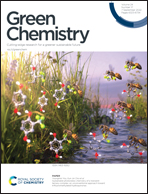Making more from bio-based platforms: life cycle assessment and techno-economic analysis of N-vinyl-2-pyrrolidone from succinic acid†
Abstract
The prospective assessment of the environmental and economic costs of emergent technologies based on biomass feedstocks has a vital role in guiding academic research and corporate investments. This study evaluates a new pathway for the synthesis of the established monomer N-vinyl-2-pyrrolidone (NVP) from succinic acid, a suggested biorefinery platform chemical. For this purpose, conceptual process design is combined with recent progress in catalysis research to deliver the life cycle inventories of the novel process route. LCA projects that bio-based NVP production reduces global warming impacts by 25–53% compared to the fossil alternative practiced today. Within this range, the magnitude of reductions depends on the biomass feedstock, the chosen hydrogenation catalyst, and separation technology. However, these global warming impact reductions have to be weighed against increasing other environmental impacts, mainly eutrophication and acidification, which are associated with farming and the expenditure of noble metal catalysts. The operational cost analysis suggests that succinic acid-based NVP production is competitive if the substrate cost ratio (succinic acid/γ-butyrolactone) is lower than 0.7. The insights gained in this study provide goals for catalyst research and process development.



 Please wait while we load your content...
Please wait while we load your content...